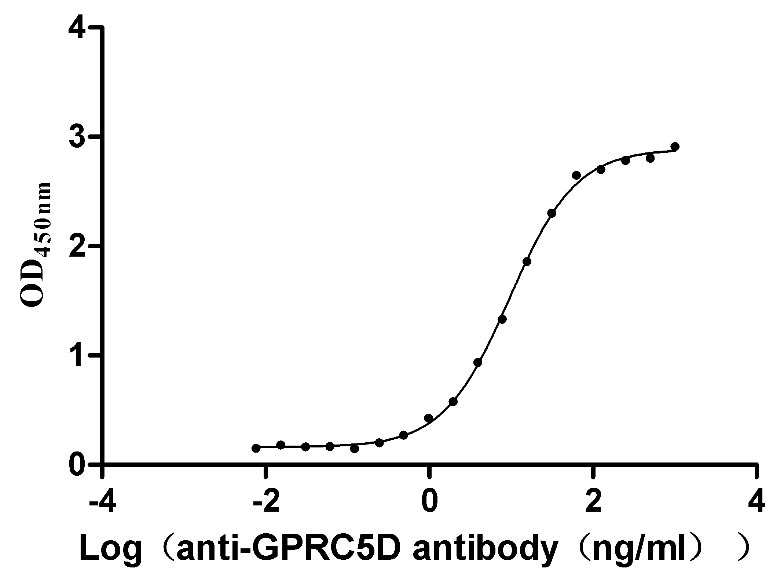Recombinant Candida glabrata Heat shock protein SSB (SSB1), partial
-
中文名稱:光滑假絲酵母SSB1重組蛋白
-
貨號:CSB-YP803181CZI
-
規(guī)格:
-
來源:Yeast
-
其他:
-
中文名稱:光滑假絲酵母SSB1重組蛋白
-
貨號:CSB-EP803181CZI
-
規(guī)格:
-
來源:E.coli
-
其他:
-
中文名稱:光滑假絲酵母SSB1重組蛋白
-
貨號:CSB-EP803181CZI-B
-
規(guī)格:
-
來源:E.coli
-
共軛:Avi-tag Biotinylated
E. coli biotin ligase (BirA) is highly specific in covalently attaching biotin to the 15 amino acid AviTag peptide. This recombinant protein was biotinylated in vivo by AviTag-BirA technology, which method is BriA catalyzes amide linkage between the biotin and the specific lysine of the AviTag.
-
其他:
-
中文名稱:光滑假絲酵母SSB1重組蛋白
-
貨號:CSB-BP803181CZI
-
規(guī)格:
-
來源:Baculovirus
-
其他:
-
中文名稱:光滑假絲酵母SSB1重組蛋白
-
貨號:CSB-MP803181CZI
-
規(guī)格:
-
來源:Mammalian cell
-
其他:
產(chǎn)品詳情
-
純度:>85% (SDS-PAGE)
-
基因名:SSB1
-
Uniprot No.:
-
別名:SSB1; CAGL0C05379g;; SSB2; CAGL0K04741gRibosome-associated molecular chaperone SSB; EC 3.6.4.10; Heat shock protein SSB; Hsp70 chaperone Ssb
-
種屬:Candida glabrata (strain ATCC 2001 / CBS 138 / JCM 3761 / NBRC 0622 / NRRL Y-65) (Yeast) (Torulopsis glabrata)
-
蛋白長度:Partial
-
蛋白標(biāo)簽:Tag?type?will?be?determined?during?the?manufacturing?process.
The tag type will be determined during production process. If you have specified tag type, please tell us and we will develop the specified tag preferentially. -
產(chǎn)品提供形式:Lyophilized powder
Note: We will preferentially ship the format that we have in stock, however, if you have any special requirement for the format, please remark your requirement when placing the order, we will prepare according to your demand. -
復(fù)溶:We recommend that this vial be briefly centrifuged prior to opening to bring the contents to the bottom. Please reconstitute protein in deionized sterile water to a concentration of 0.1-1.0 mg/mL.We recommend to add 5-50% of glycerol (final concentration) and aliquot for long-term storage at -20℃/-80℃. Our default final concentration of glycerol is 50%. Customers could use it as reference.
-
儲存條件:Store at -20°C/-80°C upon receipt, aliquoting is necessary for mutiple use. Avoid repeated freeze-thaw cycles.
-
保質(zhì)期:The shelf life is related to many factors, storage state, buffer ingredients, storage temperature and the stability of the protein itself.
Generally, the shelf life of liquid form is 6 months at -20°C/-80°C. The shelf life of lyophilized form is 12 months at -20°C/-80°C. -
貨期:Delivery time may differ from different purchasing way or location, please kindly consult your local distributors for specific delivery time.Note: All of our proteins are default shipped with normal blue ice packs, if you request to ship with dry ice, please communicate with us in advance and extra fees will be charged.
-
注意事項(xiàng):Repeated freezing and thawing is not recommended. Store working aliquots at 4°C for up to one week.
-
Datasheet :Please contact us to get it.
靶點(diǎn)詳情
-
功能:Ribosome-bound, Hsp70-type chaperone that assists in the cotranslational folding of newly synthesized proteins in the cytosol. Stimulates folding by interacting with nascent chains, binding to short, largely hydrophobic sequences exposed by unfolded proteins, thereby stabilizing longer, more slowly translated, and aggregation-prone nascent polypeptides and domains that cannot fold stably until fully synthesized. The Hsp70-protein substrate interaction depends on ATP-binding and on allosteric regulation between the NBD and the SBD. The ATP-bound state is characterized by a fast exchange rate of substrate (low affinity state), while in the ADP-bound state exchange is much slower (high affinity state). During the Hsp70 cycle, the chaperone switches between the ATP-bound state (open conformation) and the ADP-bound state (closed conformation) by major conformational rearrangements involving mainly the lid domain. Ssb cooperates with a specific Hsp40/Hsp70 co-chaperone termed the ribosome-associated complex (RAC), which stimulates the ATPase activity of the ribosome-associated pool of Ssbs and switches it to the high affinity substrate binding state. Hsp110 chaperone SSE1 and FES1 act as nucleotide exchange factors that cause substrate release.
-
亞細(xì)胞定位:Cytoplasm.
-
蛋白家族:Heat shock protein 70 family, Ssb-type Hsp70 subfamily
-
數(shù)據(jù)庫鏈接:
KEGG: cgr:CAGL0C05379g
STRING: 284593.XP_448432.1
Most popular with customers
-
Recombinant Human IGF-like family receptor 1 (IGFLR1), partial (Active)
Express system: Mammalian cell
Species: Homo sapiens (Human)
-
Recombinant Human Melanoma-associated antigen 4 (MAGEA4) (Active)
Express system: Mammalian cell
Species: Homo sapiens (Human)
-
Recombinant Human G-protein coupled receptor family C group 5 member D (GPRC5D)-VLPs (Active)
Express system: Mammalian cell
Species: Homo sapiens (Human)
-
Express system: Mammalian cell
Species: Macaca fascicularis (Crab-eating macaque) (Cynomolgus monkey)
-
Recombinant Human IL12B&IL12A Heterodimer Protein (Active)
Express system: Mammalian cell
Species: Homo sapiens (Human)
-
Recombinant Mouse Complement component C1q receptor (Cd93), partial (Active)
Express system: Mammalian cell
Species: Mus musculus (Mouse)
-
Recombinant Human Interleukin-2 (IL2) (Active)
Express system: Mammalian cell
Species: Homo sapiens (Human)
-
Recombinant Human Serotransferrin(TF) (Active)
Express system: Mammalian cell
Species: Homo sapiens (Human)


















